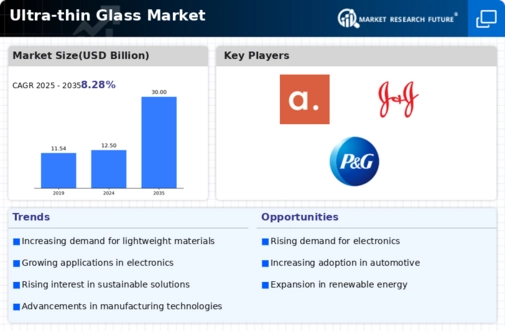By region, the study provides market insights into North America, Europe, Asia-Pacific, and the Rest of the World. The Asia Pacific region has been a major market for the Ultra-thin Glass industry and has exhibited a high demand for the product. This is mainly due to the rapid industrialization and urbanization in countries such as China, Japan, South Korea, and India, which has led to the growth of various end-use industries, including electrical & electronics, automotive, and construction, among others.
The rising demand for smartphones, tablets, and other electronic devices, especially in countries such as China and India, has been a significant factor driving the demand for Ultra-thin Glass in the region. In addition, the growing demand for lightweight and fuel-efficient vehicles has increased the use of Ultra-thin Glass in the automotive industry in the Asia Pacific region. Moreover, the region's robust construction industry, coupled with the increasing adoption of green building practices, has boosted the demand for Ultra-thin Glass in the construction sector.
Further, the major countries studied in the market report are The U.S., Canada, Germany, France, the UK, Italy, Spain, China, Japan, India, Australia, South Korea, and Brazil
Figure 3: ULTRA-THIN GLASS MARKET SHARE BY REGION 2022 (%) Source: Secondary Research, Primary Research, Market Research Future Database and Analyst Review
Source: Secondary Research, Primary Research, Market Research Future Database and Analyst Review
Europe’s Ultra-thin Glass market accounts for the third-largest market share. This is mainly due to the increasing adoption of Ultra-thin Glass in various industries, including electrical & electronics, automotive, and healthcare, among others. The European Union has been investing heavily in research and development activities to support the growth of the Ultra-thin Glass market and promote sustainable economic development. The region's robust automotive industry, coupled with the growing demand for lightweight and fuel-efficient vehicles, has increased the use of Ultra-thin Glass in the industry.
In addition, the increasing focus on energy efficiency and sustainable building practices in the construction industry has boosted the demand for Ultra-thin Glass in the region. The use of Ultra-thin Glass in green buildings, such as photovoltaic glass, has gained popularity in Europe, contributing to the growth of the Ultra-thin Glass market. Further, the Germany Ultra-thin Glass market held the largest market share, and the UK Ultra-thin Glass market was the fastest-growing market in the European region.
North America has been a significant market for Ultra-thin Glass, with the increasing adoption of advanced technologies and the presence of major players in the region. The growing demand for lightweight, flexible, and durable glass for use in smartphones, tablets, and other electronic devices, as well as in the automotive and construction industries, is expected to drive the demand for Ultra-thin Glass in the region. In addition, the rising focus on energy efficiency and sustainable building practices in the construction industry is expected to boost the demand for Ultra-thin Glass in the region.
Therefore, North America may present growth opportunities for the Ultra-thin Glass market in the future. Moreover, the U.S. Ultra-thin Glass market held the largest market share, and the Canada Ultra-thin Glass market was the fastest-growing market in the North American region.



 Source: Secondary Research, Primary Research, Market Research Future Database and Analyst Review
Source: Secondary Research, Primary Research, Market Research Future Database and Analyst Review










Leave a Comment